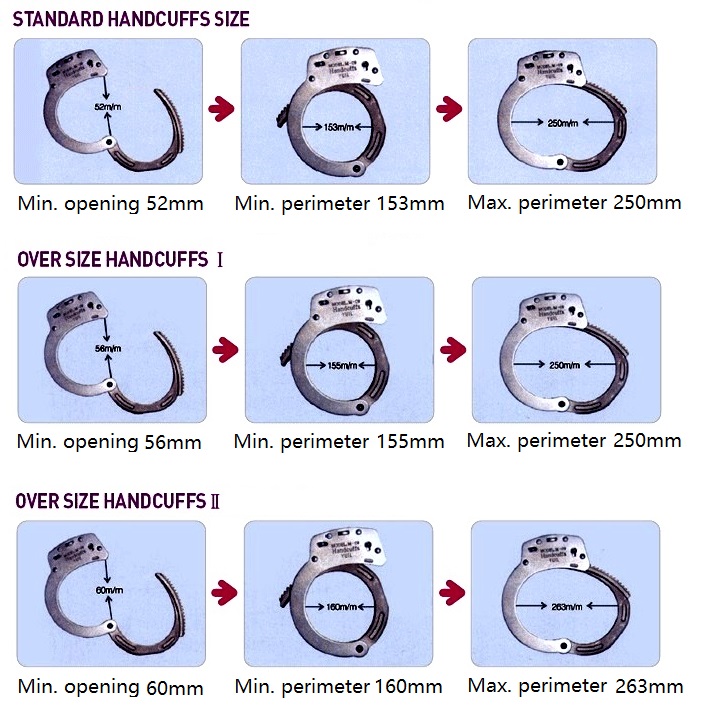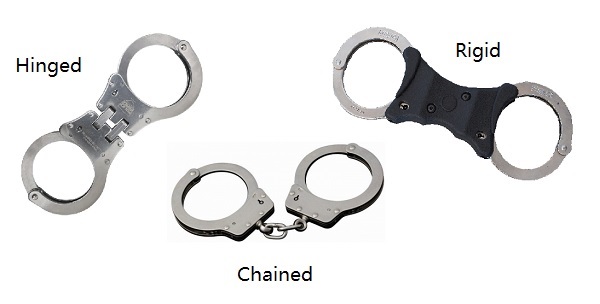Sizes and types of handcuffs
Sizes and types of handcuffs: There are mainly three sizes for non-flex handcuffs: standard, over-sized one and oversized two. The following illustrations explain the differences.

There are many more sizes for flex handcuffs (disposable type), please refer to manufacturer’s specifications.
Sizes and types of handcuffs: metallic
There are four types of handcuffs. Hinged, chained, rigid and flex (disposable).

1, Hinged handcuffs
Hinged cuffs connect with a large hinge reducing the mobility. If you get one handcuff on a suspect fighting with you, hinged cuffs allow you to use defensive tactics, such as to torque the handcuff to an angle that hurts, to persuade a suspect to cooperate.
The hinge also makes these handcuffs stronger, and it would take someone to break chained cuffs but be very rarely to break a hinged one, your arrestee isn’t escaping hinged cuffs. Hinged handcuffs can be folded in half and put in a handcuff pouch.
2, Chained handcuffs
Chained handcuffs are the other common cuff carried by law enforcement officers. They give suspects a little more mobility than hinged cuffs. They are easy to use on most people and better for larger and muscular people. Chained handcuffs aren’t quite as strong as hinged cuffs, but there have only been a few occurrences where someone broke the chain.
Like hinged cuffs, chained handcuffs can be placed on an arrestee with just one hand, and can be folded easily into a handcuff pouch.
3, Bar handcuffs, or rigid handcuffs
These handcuffs aren’t commonly used but offer a safer option for transporting inmates that aren’t compliant. The two cuffs connect with a solid bar instead of a chain or hinge. They are resistant to tampering, just like hinged cuffs, only they offer the subject even less mobility. Bar handcuffs allow police officers to use pain compliance techniques to control arrestees and maintain more control for a safer arrest process.
4, Disposable restraints (flex cuffs)
There are some instances where officers arrest more than two people. When police respond to riots or other calls for service involving many people, It’s difficult to keep large numbers of chained or hinged cuffs in your patrol car, so officers carry flex cuffs or disposable cuffs for the times they need to arrest multiple people. They’re easy to apply, and they cut off easily.
They should only be used as an alternative to handcuffs when you run out of the ones you carry in your car, patrol bag, or handcuff pouch. Flex cuffs aren’t as sturdy or tamperproof as conventional handcuffs.
Sizes and types of handcuffs, flex
Disposable restraints or Flex cuffs can be made of plastic or metal materials.
Stainless Steel Zip Ties.
UV Black Nylon Cable Ties.
Natural Color Nylon Cable Ties.
Colored Nylon Cable Ties.
Which is better? It depends.
Beside sizes and types of handcuffs, the biggest difference between handcuffs available today is the way they’re connected. The two main types of handcuffs are hinged and chained. Hinged cuffs are the most secure because they cut down on an arrestee’s movement, making the entire arrest process safer. They are more painful for the suspect and often don’t work on larger or more muscular people. But these handcuffs give law enforcement officers more control over their arrests, which can be excellent for combative or argumentative suspects.
Chained handcuffs allow the arrested person more flexibility and movement, which is necessary in some cases. You can use these on more docile arrestees or larger people. Sometimes extremely muscular people need to be restrained with two sets of cuffs because it’s difficult to bring their hands together behind their backs. Officers usually use two sets of chained cuffs in these instances.
Most officers carry both types of handcuffs in their patrol bags, as well as flex cuffs for more choices when securing someone and for the ability to arrest more than one subject. Sometimes police departments give officers the discretion to handcuff in the front or back, but this should rarely be done in instances with non-combative mental health transports or elderly people. There may occasionally be other people who are safe enough to transport handcuffed in the front.

